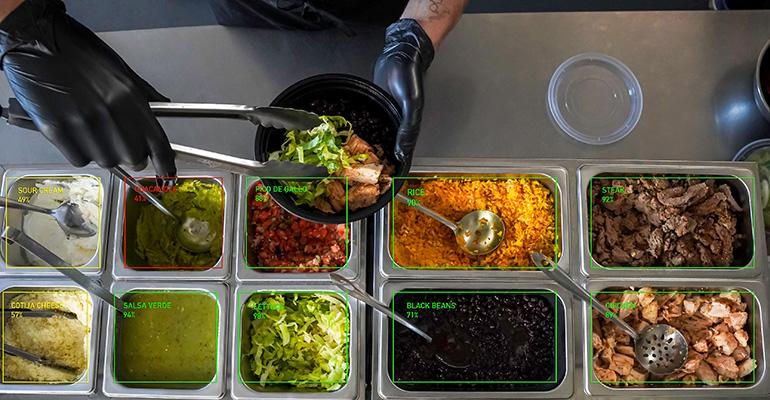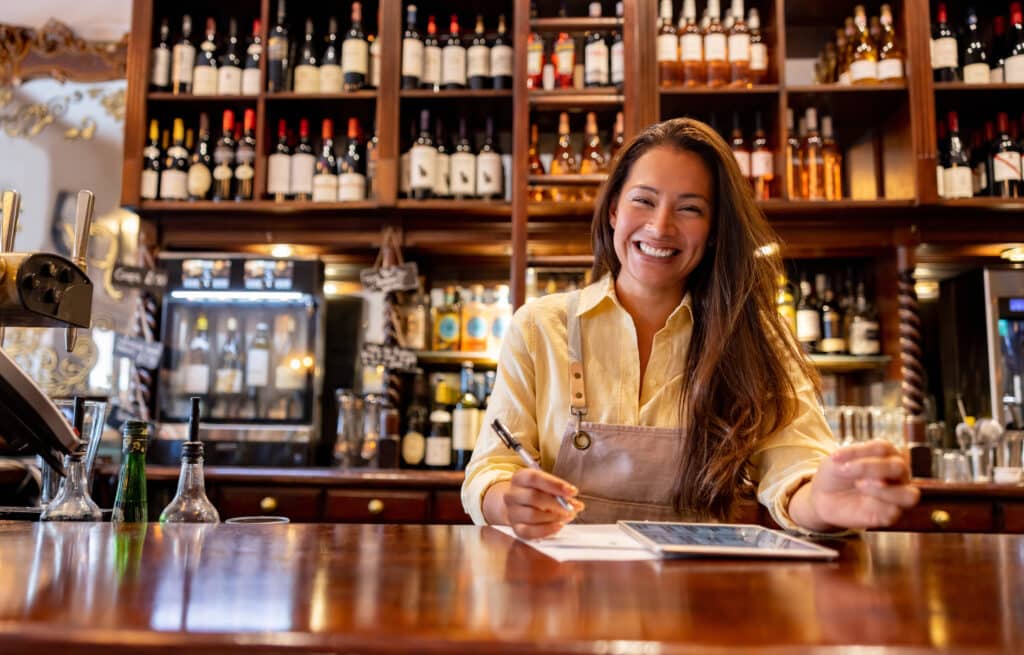This article originally appeared in Nation’s Restaurant News.
Going paper-free and using smart tech to keep track of inventory, food waste, and energy usage is one way to become more sustainable, and it could also help your bottom line.
When one thinks of the growth of restaurant sustainability, plant-based burger chains that make their small carbon footprint a major part of their brand identity might come to mind. One might also think of restaurants that only use recyclable or compostable packaging or have gone nearly zero-waste in using every part of the vegetables and animals that are brought into their kitchen.
But going vegan or investing in paper straws aren’t the only ways for a restaurant to improve upon their sustainability. A new generation of smart technology sits at the intersection of sustainability and profitability, and many of these tools are becoming more popular because of their long-term return on investment.
These types of sustainability software companies can even be crucial for independent restaurants like Von Elrod’s, which has not only gone paper-free but has also started to rely heavily on its inventory management partnership with Restaurant365.
As the restaurant industry becomes more digitized, one very simple example of how operators have almost universally become greener is by using less paper. With QR code ordering and digital receipts, many restaurants are using way less thermal paper than they used to. When the team at Von Elrod’s Beer Hall & Kitchen in Nashville was looking for an easy way to reduce their environmental impact, they immediately thought of ditching thermal paper, which — unlike regular paper — does not easily decompose and can release chemicals like BPAs into the atmosphere.
“When we were thinking about little things we could do to minimize our impact, we started adding handhelds and KDS screens and digitizing a lot of our stuff,” said Hillary Holmes, general manager at Von Elrod’s. “Now we aren’t going through all of these wasteful print materials. A lot of people don’t think about the impact of kitchen printers … but now we’re 95% paper-free and our workers don’t have to squint at tiny receipts anymore.”
And while the initial purpose of switching to QR codes instead of paper menus and ditching paper receipts might not have been sustainability, it is a happy byproduct and side effect. This has been a recurring motif in the hospitality technology space: For many restaurants, using tech to save money on energy, ingredient inventory and even frying oil is a capitalistic decision. But as HVAC systems and inventory management software get smarter, they can help reduce your carbon footprint while also shrinking your energy and supplier bills.
This is why efficiency is so crucial, especially for restaurant operators who have to worry about ongoing labor and inflation challenges. Putting up a lot of money, time and effort into investing in something like solar power or getting rid of plastic is not going to immediately appeal to the average restaurateur.
“These are really busy folks that have a lot on their plates, so we have to make it easy for sustainability-oriented solutions to take off,” said Manik Suri, CEO and founder of smart cooling company Therma. “You can’t expect massive market adaptation, especially if you make it hard . And that’s where smart technologies can be really powerful. That has been the role of technology since the beginning of human civilization, whether it’s a washing machine, a microwave or an energy sensor.”
Therma is a solutions-based technology company that helps restaurants curtail their energy bills using IOT (Internet of Things) technology that makes “dumb” devices like refrigerators “smart” by installing temperature and humidity sensors into the appliance. Before smart technology, a lot of energy-saving solutions consisted of expensive investments, like advanced insulation and solar panels, Suri said.
“If you can see a way to adopt sustainability technology that also saves you money or streamlines operations, then it’s a lot easier to make that case to owners and managers,” he said. “We see a lot of folks that want to do the right thing, but they also need to justify it on a financial basis.”
Smart HVAC software could be one piece of a larger sustainability puzzle, and while it might not be as buzz-worthy as an entirely vegan menu or going zero-waste, installing software that tracks your energy usage and senses air leaks could save 5-15% off your energy bill for the month, Suri said.
Reducing energy costs is a big trend among green tech companies in the hospitality space. Budderfly is an energy efficiency service company that operators can hire to upgrade their kitchen equipment, HVAC system and lighting to the latest energy-efficient, smart models that can turn off equipment during slow times to save energy.
While it doesn’t cost money upfront, Budderfly takes a sizeable chunk of the ROI from using the efficient equipment, while the operator gets to keep a piece of it. And while this may sound a little too good to be true — and very much like the next generation of Energy Star equipment — Budderfly CEO Al Subbloie said that restaurant operators are surprisingly not keeping up with the evolving technology.
“An operator might tell me, ‘I don’t want to spend money on new lights — I already have lights!’ even though they know their bill will be less if they invest in the new LEDs. But because it’s a three or four-year return, they’re like ‘forget about it,’” Subbloie said. “So they’re putting their money directly into their business and not into their infrastructure. … In my view, their equipment might need to be replaced, but they’re like, ‘I’ll wait until it dies and then deal with it.’”
His advice? Ignore the bells and whistles of installing solar panels and EV charging systems — even though that might make headlines — and focus on investing in the basic energy-efficient equipment that can have a real impact on energy and gas bills, like replacing refrigeration seals on doors.
Budderfly works with many of the larger restaurant companies, including Inspire Brands and Dine Brands. Subbloie said that larger operators and franchisors are more likely to invest in sustainability technology than their franchisees or smaller operators because they have more capital to think in terms of long-term return on investment.
Chipotle is a prime example of a larger, franchisee-free restaurant chain that invests in and advertises sustainability as a brand feature systemwide. Over the past few years, the burrito bowl chain has installed energy management systems to improve efficiency and is piloting a test of a smart inventory management system in partnership with PreciTaste. Much like energy efficiency and paper-free operations, inventory management systems help restaurants become more sustainable while helping their bottom line. Restaurants primarily partner with companies like PreciTaste to have a steady source of fresh ingredients, while ditching unnecessary inventory; being able to rid their small corner of the planet of excess food waste is a welcome side effect.
“We are piloting a cook-to-needs kitchen management system that provides demand-based cooking and ingredient preparation forecasts to optimize throughput and freshness while minimizing food waste,” Laurie Schalow, chief corporate affairs officer at Chipotle, told Nation’s Restaurant News. “Early results indicate the pilot is effectively streamlining kitchen operations for crew members while always ensuring a full line of fresh ingredients for guests.”
Though inventory management systems are nothing new, they are becoming smarter. Food inventory management companies like PreciTaste and Choco use AI-based forecasting tools to predict how much a restaurant kitchen will need of a particular ingredient based on past customer traffic, sales data, and forecasting predictions. The restaurant can then purchase and prepare the (fairly) accurate amount of food it will need and throw less food away, which of course is an environmental win.
“Let’s assume I own a sports bar with outdoor seating and tomorrow is a big football game,” said Choco founder and CEO Daniel Khachab. “I might assume it will be crowded, but it’s also going to rain so fewer people will want to sit outside. I could figure out how much by gut feeling or by pen and paper, or I can use smart data to check it on the app. I can see that maybe last week I wasted 10 pounds of food, so I can adjust to improve this week. … If you make it easy for people to avoid food waste, they will want to do it.”
Khachab claims that with smart food inventory management, an operator can reduce up to 80% of food waste. These types of sustainability software companies can even be crucial for independent restaurants like Von Elrod’s, which has not only gone paper-free but has also started to rely heavily on its inventory management partnership with Restaurant365.
“We used to have the baker just estimate how many pretzels he might need on a particular evening, but now, with getting into inventory and sales tracking, we can be much more precise,” Holmes said. “Maybe we need 350 pretzels Saturday and only 60 on Tuesday, so we’re not throwing away pretzels early in the week, but we’re not running out by the weekend either. We can allocate it to the right times.”
Holmes said that over the past two years, the restaurant has been able to drop 2% of its food waste, which, while a far cry from the 80% quoted by Choco, still comes out to about $1,500 saved per week.
Whether restaurants are investing in new sustainability technology to shrink their carbon footprint or to save money on their energy and supplier bills, it makes an impact all the same.
“A lot of the newer sustainability technology companies have dropped the payback period, so now you’re ROI-positive from day one,” Therma’s Suri said. “More restaurant brands these days want to position themselves as sustainability-focused because that’s what younger consumers want these days. But you don’t have to bleed green to make a difference. You don’t have to be a climate activist. It’s just good business.”



